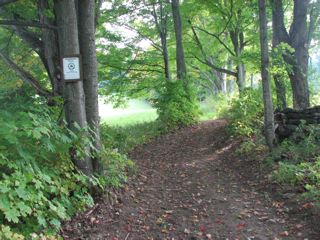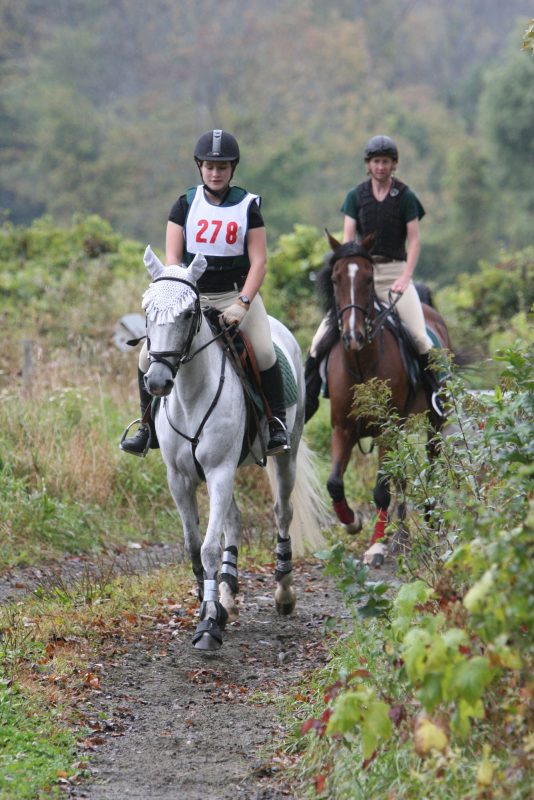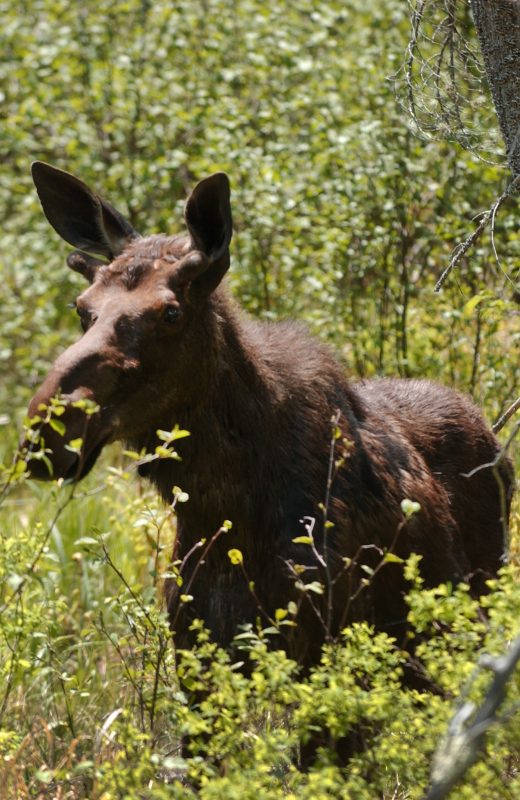by Chelle Grald
The paradox of living in a trail rich environment is that the more trail users there are, the bigger the potential for conflict. At the root of this conflict are varying goals for the trail. Hikers, bikers, snowmobilers, ATV operators and equestrians all have different versions of the perfect trail experience. Landowners may or may not share the vision of all users but may favor one or two. One group may be more active and involved than another, causing their voice to be heard and their wishes to be met to the detriment of other users. In short, it can get ugly. As equestrians, we have a responsibility to be involved in local trail use issues wherever they crop up. A spirit of cooperation and compromise and a willingness to put hands and backs into the solution will go a long way for the overall health of our trails. We need to step up – not just as organizations, but as individuals. When we do, it is helpful to arm ourselves with knowledge about horses and trail use. There are perceptions and realities. It pays to know the difference.
The Equestrian Land Conservation Resource in Lexington, Kentucky, is dedicated to helping horse people like us to preserve open spaces and trails. They recently published an article entitled Considering Trail Closures on Public Agency Lands: U.S. Fish & Wildlife Service, which contains useful information for multi-use trail discussions. This is ammunition for you as trails are discussed in your communities, particularly when closure of horse trails looms possible. Most of this information applies to both public and private trails. I’ve shared some it here and encourage you to explore further by visiting their website at ELCR.org. The sources are listed and linked if you want to dig deeper.
Perception: Trail horses pollute water
Reality: Piles of manure along the trail may be unsightly to some or inconvenient to navigate around, but they are not biohazards. There is little evidence to show that manure or urine from horses being ridden on trails contributes in any substantial way to pollution of surface or ground water. Recent scientific studies and their replicates confirm that adult horse guts do not significantly contain E. coli, Salmonela, Cryptosporidium or Giardia, which are the organisms of most concern in water-borne spread of disease.
Manure left in a loose heap in deposits on trails loses its nitrogen rapidly. Compared to other large livestock, horse manure is relatively “dry” and “hot” due to unique digestive enymes and flora. Once deposited, it breaks down and becomes environmentally neutral in 3 weeks. There is very little data about horse manure or urine’s effects on ground water or surface water when it is deposited on the trail. Bacteria and nutrient effects are seldom detectable except next to stables where horses are concentrated. Mother Nature has a buffering ability when even as little as 10 feet of vegetation is available at the side of a trail. It is important, though, to not allow your horse to urinate or defecate directly in water.
Perception: Horses carry invasive species seeds
Reality: It is very unlikely that invasive species seeds will germinate when carried in horse manure. A study funded by an American Endurance Ride Conference research grant conducted on trails in the Eastern U.S. found that germination and survivorship of non-native plants on the trail was extremely low. Furthermore, there was no difference between horse trails and hiking trails in this rate of germination. The equine gut is very efficient in processing seeds and the environment in the manure pile finishes off any survivors. It is recommended that equestrians avoid distributing any unused hay, which is a more likely carrier of viable non-native seeds.
Perception: Horses trample native plant species.
Reality: All users trample native plant species. Horses, because of their size, have the potential to do the most non-motorized per capita damage. As equestrian trail users, we can and should take responsibility to minimize our impact by staying on the trail and not tying to trees. Trail design has a large role to play here. Usually, trails are widened to the detriment of plant life because users go around muddy or wet areas, thinking that they are doing a good thing. Mitigation of mud and wet areas corrects the problem. If you see a wet area that is becoming a problem, consider donating money, time or both to get it corrected. All users will thank you.
Perception: Horses cause erosion and soil loss.
Reality: In a 5-year study, Summer (1990, 1996) concluded that horse traffic was not the single dominant process active on trails. Trail degradation was a function of landform, climatic and catastrophic events and geomorphic processes. So, natural processes are responsible for most erosion, but trail users certainly contribute to the process and horses are part of the equation. Compare the impact of a single horse versus a single hiker on the same trail and the erosion, soil disturbance and sediment creation will be three times more for the horse. That makes intuitive sense when you compare horses versus humans and consider the size, weight, number of feet, and how they are shod. The important thing to consider when weighing this is that there are far more hikers and bikers on most trails than there are horses. An Outdoor Industry Association study in 2003 estimated that nationally there are 73.3 million hikers (57% of the total), 43.1 million single track mountain bikers (25% of the total) and 4.3 million equestrians (7% of the total) with the remainder in various other uses, such as trail running. Most studies indicate that trail damage by mountain bikers is somewhere in between that of hikers and horses. So, if the trail traffic on a given day equals 57 hikers, 25 bikers and 7 horses, which user group is doing the most damage? This is why, in virtually every mixed use trail reference in the nation, the horse has been defined as a passive, low impact or light weight user, even in the most sensitive environments. In fact, horses actually help to aerate and break up areas of compaction in certain soil types and help to keep less-used single track trails open and viable. Again, trail design and maintenance are big factors here. Multi-use trails that are frequently used by horses can be designed and maintained for good sustainability. As riders, we can do our part by staying off the trails when they are wet and being willing to help build culverts, bridges and other water management structures.
Perception: Horses disturb wildlife
Reality: Studies show that horses, and the riders on them, are less a disturbance to wildlife than any other type of user, including hikers. Horses are prey animals. They are herbivores and leave the trace scent of an herbivore on the trail. Humans, dogs and cats are predators. As they walk, they leave the trace scent of omnivore on the trail that can impact wildlife. Horses are recognized by wildlife as prey animals, even when a person is sitting on their back. An approaching horse passing along a trail provides sound rhythms in the cadence of a four-footed hoofed prey animal to wildlife, which informs wildlife of a non-threatening presence. For reptiles, rodents and other terrestrial life forms, the percussion pulse of the approaching horse provides warning. Being warned diminishes flushing/flight response that consumes wildlife energy. It is not uncommon to find deer, bobcat and coyotes that allow horses to get within feet of them on trails before calmly moving off. Horses rarely step on lizards, mice and other fast moving wildlife. Riders can easily avoid slower moving wildlife. Bennett and Zuelke (1999) undertook an extensive review of recreation effects on birds and concluded that disturbance from recreation has temporary effects on behavior and movement of birds. Direct approaches caused greater disturbance than tangential approaches, rapid movement by joggers was more disturbing than slower hikers; children and photographers were especially disturbing, and passing or stopping vehicles were less disturbing than human foot traffic. Horses and riders did not disturb birds.
How to Get Along
Sharing trails may not provide the ideal trail experience for every user – hikers will have to step around an occasional manure pile, bikers will have to slow down in low visibility areas and learn to announce their presence to other users, equestrians will have to prepare their horses to tolerate fast-moving vehicles, joggers with baby carriages and other strange sights and sounds. In most cases, it is worth the price to have more trail to enjoy than any one user group would have under ‘separate but equal’ status. In frequent use areas, signage can help everyone to know to whom to yield. Choke points can be designed to slow down traffic in low visibility areas. In some cases, separate trails make sense. The Vermont Horse Council has made an excellent public service announcement called “Hikers, Bikers and Hooves” that helps to educate other trail users on the unique needs of equestrians. It is freely available at www.vthorsecouncil.org/safety. Consider sharing it with your local non-horse trail use groups as a great way to open the lines of communication.
All over the nation, multi-use is a reality that keeps trails open and healthy. As equestrians, we need to both advocate for trails and be willing to give up a few days of riding to do some trail work. When we work and play alongside other trail users, we often find that we share far more in common than otherwise and it’s a win-win for us and the trails.
GMHA Trail Work Days
We have scheduled work days every spring to tackle some straightforward trail maintenance – primarily clearing branches and trees and digging out water bars. Depending on weather and number
of volunteers, we will break up into small teams and work for 3 hours – from 9am to noon, then have lunch and you are free to go. To sign up, visit the Trail Care & Maintenance pages on our website or contact our Executive Director or Trail Event Manager at 802-457-1509.




